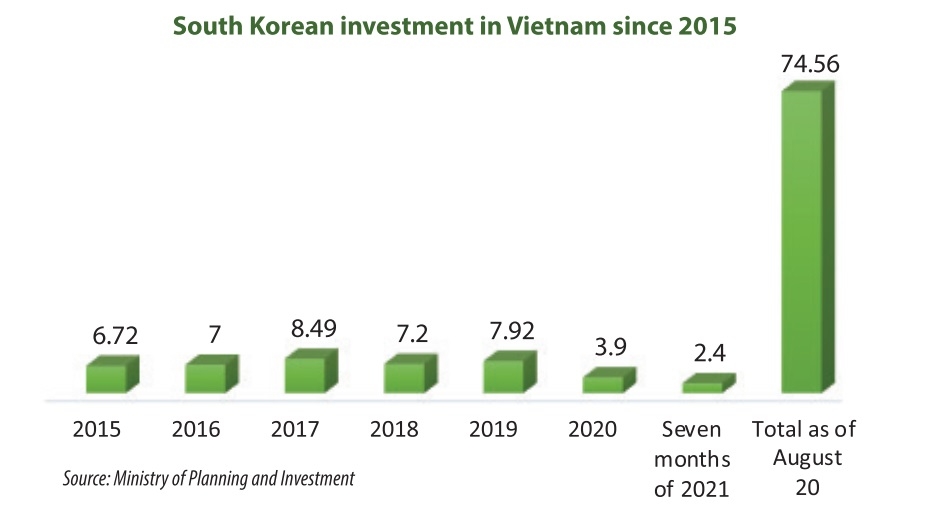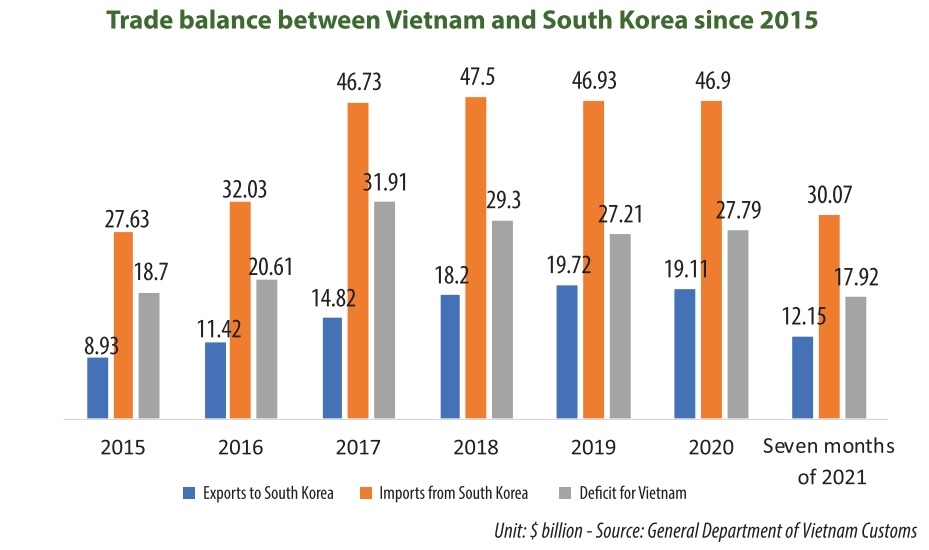South Koreans strive to keep hold of production presence
Over the past few weeks, South Korea’s LG Display Vietnam Haiphong Co., Ltd. has been boosting its recruitment of employees for its $1.5 billion plant in the northern city of Haiphong, producing OLED products for mobile phones, smartwatches, TVs, and tablets. The company is in need of lawyers, general affairs assistants, engineers for research and development, production, health and safety, and technology, and IT assistants as well.
Meanwhile, LG Electronics Vietnam Haiphong has been doing the same, with many engineers and staff required for its $1.5 billion facility making home appliances, smartphones, and car infotainment products.
South Korea’s Samsung has also followed suit, with new employees to work for its plants in Ho Chi Minh City, Hanoi, and the northern provinces of Bac Ninh and Thai Nguyen, with total investment capital of over $17.5 billion and employing over 160,000 local workers. Samsung’s production focuses on mobile phones and home electronics appliances, both locally consumed and exported.
Both Samsung and LG are taking the lead in Vietnam’s export of electronics items. In the first seven months of 2021, the country earned $29.4 billion from exporting mobile phones and their spare parts, which accounted for 15.8 per cent of Vietnam’s total export turnover and up 11.9 per cent on-year. The country also fetched $27.4 billion, up 16.5 per cent on-year from exporting laptops, their spare parts, and other electronics items.
However, according to the Korea Chamber of Business in Vietnam (KorCham), many of the 9,300 South Korean businesses in Vietnam have also boosted imports worth tens of billions of US dollars into Vietnam since early this year, in defiance of the health crisis. This has caused a trade deficit between both nations, whose trade relations are strongly increasing.
In the first seven months of this year, South Korea was Vietnam’s third-largest foreign investor, with total new registered capital of $2.4 billion, after Singapore ($6.2 billion) and Japan ($3.2 billion).
Figures from the General Department of Vietnam Customs showed that in the first seven months of this year, Vietnam’s total export-import turnover with South Korea hit $42.22 billion, or 11.25 per cent of Vietnam’s total trade turnover of $375.12 billion, and up from $35 billion recorded in the same period last year.
Also in the first seven months of 2021, South Korea was Vietnam’s fifth-largest export market with a total turnover of $12.15 billion, up 12 per cent on-year and accounting for 6.5 per cent of Vietnam’s total export turnover of $186.35 billion – up 26.2 per cent as compared to that in the corresponding period last year.
Meanwhile, South Korea was also Vietnam’s second-largest import market, with total turnover of $30.07 billion, up 21.4 per cent on-year, and occupying 15.9 per cent of Vietnam’s total import turnover of $188.76 billion – a 35.8 per cent rise on-year.
Thus, in the first seven months of the year, Vietnam witnessed a trade deficit of $17.92 billion with South Korea (see box).
Little to worry about
KorCham vice chairman Hong Sun told VIR that the trade deficit is not a negative for Vietnam, because many South Korean corporations have been boosting investment and imports of machinery, equipment, and materials into Vietnam to serve production. A large part of Vietnamese-made products are also exported to foreign markets such as South Korea.
“Many are showing their concern about a big trade deficit for Vietnam from South Korea. However, they shouldn’t because Vietnam’s imports from South Korea are largely conducted by South Korean businesses in Vietnam, especially major ones like Samsung, LG, Hyosung, and HanHwa that are implementing large investments here,” Sun said.
Meanwhile, Vietnam’s exports to South Korea, mostly end-products and consumer goods, have risen quickly by double digits over the past few years.
Under the Vietnam-Korea Free Trade Agreement, since 2018 over 90 per cent of the import tariff lines have been eliminated. Moreover, Vietnam will completely remove its import duties on nearly 90 per cent of all products from South Korea over a 15-year period from 2015.
 |
Tariff reduction and elimination by South Korea are expected to offer new opportunity for export of Vietnam’s important export-categories such as agro-products, pivotal aqua-products of shrimp, fish, tropical fruits, industrial products of garment, mechanical instruments.
South Korea is also committing to grant market access in service and investment and has agreed to promote economic cooperation, technical support in diversified sectors. South Korea, for the first time, opens its market for products of high sensitivity such as garlic, ginger, honey, shrimp, offering considerable opportunities for Vietnam in competition with other suppliers from across the region.
Vietnam commits to offer concession for South Korea in categories of industrial products such as garment materials and accessories, plastic materials, electronic accessories, trucks and cars having capacity of 2,500cc and more, car-parts, electrical home appliances, steel products, and cables.
 |
Facilitating trade
On July 22, Prime Minister Pham Minh Chinh had phone talks with South Korean counterpart Kim Boo Kyum to discuss specific measures promoting bilateral strategic cooperative partnership, towards the 30th anniversary of bilateral diplomatic ties.
They reached a consensus on achieving the target of lifting two-way trade to $100 billion in a balanced trade manner, including facilitating Vietnam’s key exports such as agro-forestry-fishery products and seasonal fruits.
Vietnam vowed to create all favourable conditions for South Korean businesses to continue expanding and shifting investment to the nation while actively assisting those hit by COVID-19.
Both nations are also expected to implement a plan on opening their doors wider to each other to boost trade and investment ties.
During an official visit to South Korea last November by Prime Minister Nguyen Xuan Phuc, now Vietnam’s state president, President Moon Jae-in stressed that Vietnam is “a key partner in South Korea’s New Southern Policy”, and that South Korea wishes that both nations continue boosting the bilateral ties to new highs.
Figures from the Vietnamese General Statistics Office showed that as of August 20, South Korea is Vietnam’s biggest foreign investor, with over 9,100 valid projects registered at $72.16 billion.
Samsung is now the biggest foreign investor in Vietnam. It is now constructing a $230 million research and development centre in Hanoi, which is expected to become operational in 2022, employing 2,200-3,000 people.
Despite massive difficulties, Samsung’s export turnover last year sat at $57 billion, holding 20.16 per cent of Vietnam’s total export turnover of $282.65 billion. This was an important milestone for the company as one of its most important branches, Samsung Electronics, aims to become the largest chip manufacturer in the industry, targeting a value of around $400 billion in the global market.
However, KorCham’s Hong Sun said that many big brand names such as Adidas and Nike have delayed signing new contracts with enterprises in Vietnam for fear that they cannot meet the conditions.
“The Christmas holiday will see the biggest consumption of products and production must begin now, but producers are afraid that their partners will turn to India, Malaysia, or Pakistan which are also famous for footwear products,” Sun said. “It is suggested that the Vietnamese government are flexible in controlling COVID-19 and supporting enterprises thoroughly.”
What the stars mean:
★ Poor ★ ★ Promising ★★★ Good ★★★★ Very good ★★★★★ Exceptional
 Tag:
Tag:
Related Contents
Latest News
More News
- Vietnam’s green transition demands collective financial action (December 15, 2025 | 12:00)
- VIR workshop highlights capital and policy for sustainable development (December 15, 2025 | 11:00)
- National Assembly approves pilot mechanisms to accelerate major projects in Hanoi (December 12, 2025 | 11:29)
- Vietnam eases policy approval requirements, simplifies foreign and outbound investments (December 11, 2025 | 17:53)
- Unpacking new momentum in Vietnam’s M&A market (December 10, 2025 | 09:59)
- Forum honours outstanding M&A deals, strategies, and advisory firms (December 09, 2025 | 18:22)
- Vietnam enters defining phase of M&A growth (December 09, 2025 | 17:00)
- Vietnam’s M&A market opens new opportunities amid strong economic momentum (December 09, 2025 | 15:00)
- Vietnam M&A Forum 2025: new position, new momentum (December 09, 2025 | 14:30)
- FDI in Vietnam jumps on additional capital and share purchases (December 09, 2025 | 13:56)
























 Mobile Version
Mobile Version